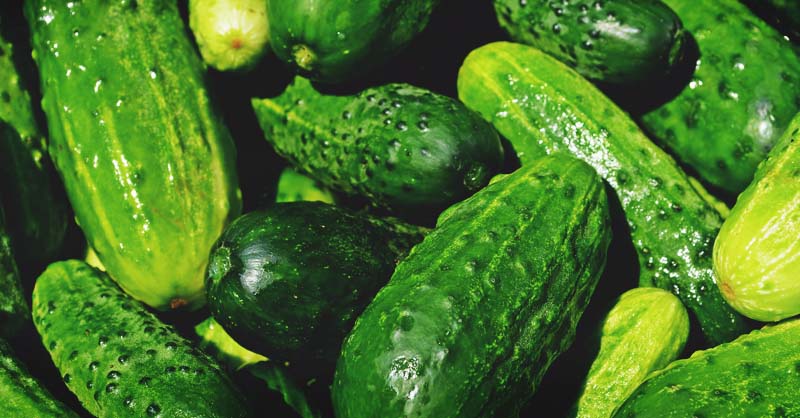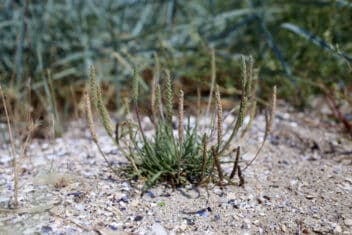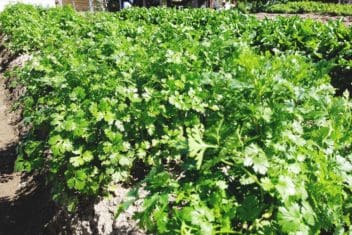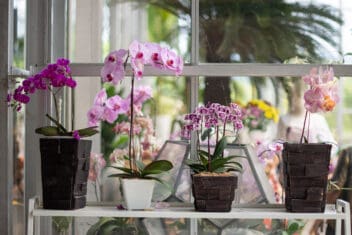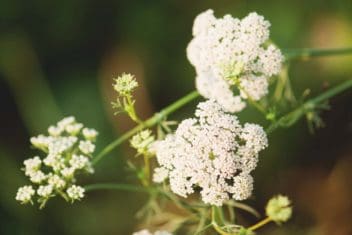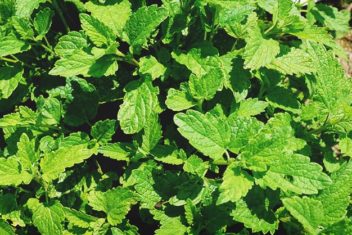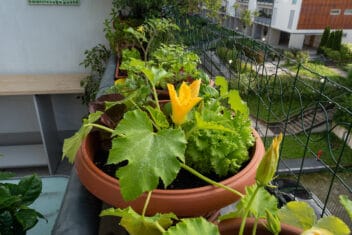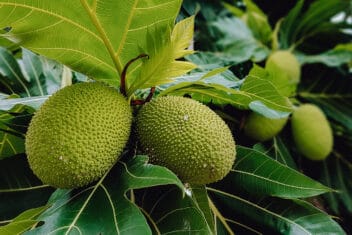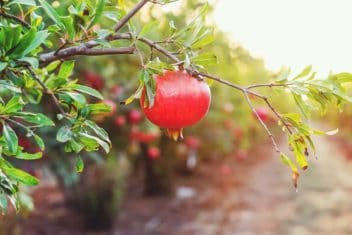Are you a fan of pickles? One of my boys’ favorite snacks is gherkin pickles, while I love cucumbers dipped in homemade ranch dressing.
If you’re a cucumber fan too, then you should be growing them in your garden. They’re fuss-free and you only need a few plants to have an abundant harvest.
Whether you have a traditional garden or a container garden, this vegetable could be a great fit for you.
Let’s dive in.
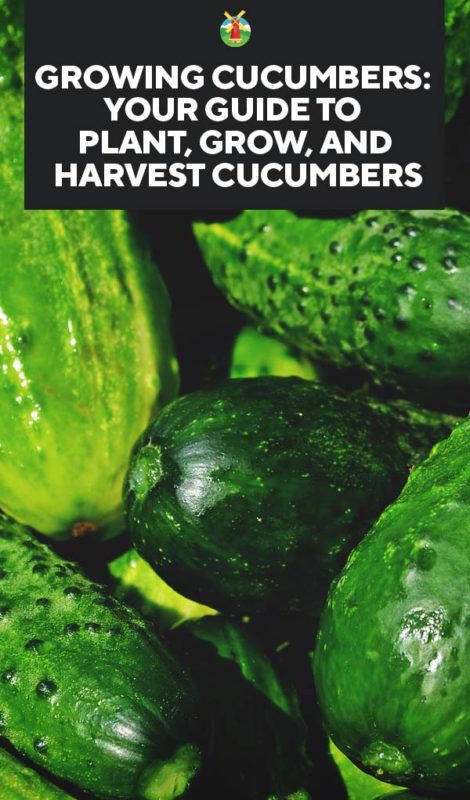
Quick Gardening Facts for Cucumbers
- Hardiness Zones: 4, 5, 6, 7, 8, 9, 10, 11 (find yours)
- Soil: Loamy, PH between 6.0 to 7.0, well-drained
- Sun Exposure: Full sun, at least 5 hours of sun per day
- Planting:
- Start Indoors: 1-2 weeks before last frost date
- Hardening Off: 7 to 10 days before transplanting
- Transplant Outdoors: 2 weeks after last frost date or 3 weeks after indoor seed starting
- Spacing: 6 to 10 inches between plants and 2 to 4 feet between rows
- Depth: ¾ to 1-inch seed depth
- Best Companions: Bush beans, cabbage, corn, dill, peas, pumpkin, lettuce, sunflower, broccoli, cauliflower, asparagus, radish
- Worst Companions: Potato, sage, melon
- Watering: Deeply once a week providing at least 1 inch of water, avoid overhead watering
- Fertilizing: Apply a balanced fertilizer and compost manure before planting
- Common Problems: Thrips, aphids, stink bugs, cutworms, flea beetles, cucumber beetles, cabbage looper, scab, Pythium fruit rot, phytophthora blight, cucumber mosaic, squash mosaic, aster yellows, bacterial wilt, bacterial leaf spot, angular leaf spot, verticillium wilt, target leaf spot, septoria leaf spot, fusarium wilt, powdery mildew, Cercospora leaf spot, downy mildew, belly rot, anthracnose, Alternaria leaf spot
- Harvest: After 50 to 70 frost-free days, 3 to 4 inches for pickling types and 6 to 8 inches for slicers
Best Cucumbers Varieties to Plant
The varieties for cucumbers seem almost endless. I’m going to share with you some of the more popular types and their uses. It should put you on the right track for picking the best variety of cucumber for your garden.
The 2 Types of Cucumbers
The first thing to know is that there are two types of cucumber plants. Pick the type that works best for your needs.
1. Vining Cucumbers
The most common type of cucumbers are vining, and this type is quite vigorous in its growth. They grow fast and have abundant yields if you care for them properly.
You need to have a trellis or a fence as a support system for vining cucumbers. Since they grow upward, the cucumbers are cleaner and easier to pick. It’s also easier to make sure you don’t miss picking one of them.
2. Bush Cucumbers
If you have a small garden or want to grow in containers, bush cucumbers are a better choice. These grow from a central base rather than as a vine and take up less room.
You can use succession planting strategies for bush cucumbers. Typically, bush varieties take 6-8 weeks to ripen fully. They grow quickly especially in fertile soil
Here are some good options of both vining and bush cucumbers to check out:
Carolina
Carolina cucumbers are a vine-type reach maturity in 51 days. They’re an excellent choice for pickling and are well known for being uniform in shape.
Armenian
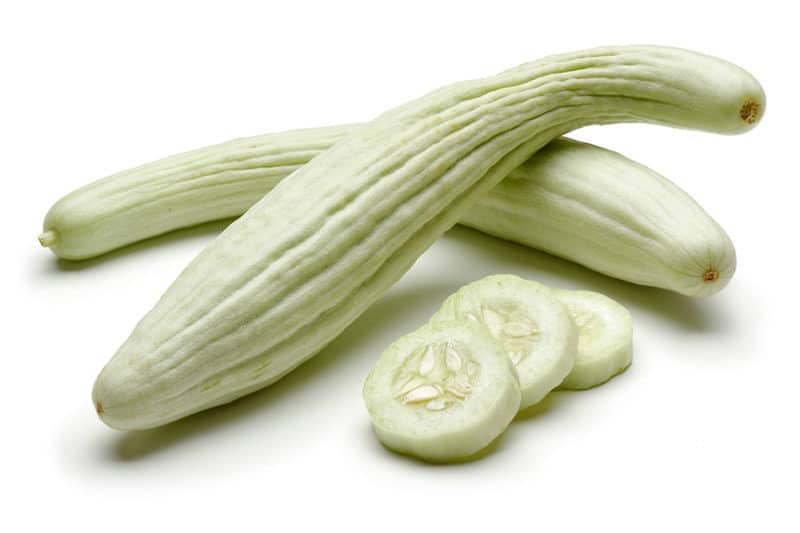
The Armenian variety is different from traditional style cucumbers. They take 50-75 days to reach maturity.
You don’t have to peel this variety or seed them either, which makes this an excellent choice for snacking, or as an addition to your salads.
Armenian cucumbers are a vine grower.
Suyo Long
This vine-type variety of cucumber takes 60 days to reach maturity for production. It has a sweet flavor and is a burpless variety. The cucumbers grow to be approximately 16 inches in length.
Suyo Long is an heirloom variety which loves hot weather and is a good choice for your salad or to make pickles. The downside is that they tend to have lots of spines.
Calypso
Calypso is one of my favorite types of cucumbers to plant. They take only 52 days to reach maturity and they produce small fruit.
Because I grow cucumbers for pickling purposes, this is a great option. If you prefer a smaller cucumber and need a variety to produce faster, this could be the right choice for your garden.
This type grows as a vine.
Spacemaster 80
Spacemaster 80 is another valuable option for a smaller cucumber variety. They take 60 days to produce and are perfect for smaller gardens or containers. The bush reaches three feet and produces eight-inch cucumbers.
English Telegraph
The English Telegraph vine variety takes only 60 days to produce. This variety is an excellent choice for snacking because the cucumbers are long, but they have a thin skin which helps to avoid the need for peeling.
Lemon
This is a neat vine variety of cucumber. At first glance, this cucumber looks like a lemon since it grows in a rounded shape and has yellow skin.
However, it only takes 65 days to produce and is an excellent option for making pickles or as a gorgeous addition to your salads.
Marketmore 86
This cucumber variety takes 55-58 days to reach maturity. It’s a great option for snacking, adding to a salad mixture, or pickling.
The cucumbers are more petite, and the plant bushes more than it vines, which makes it a wonderful addition to a small garden.
Parisian Gherkin
Parisian Gherkin cucumbers ideal for pickling. They take only 50-60 days to reach maturity and produce cucumbers with a naturally sweet flavor. Also a nice option for salads and as an addition to your slaw recipe.
This is a semi-vining variety.
Dasher II
Dasher is a disease resistant variety which is helpful for the new gardener. They take only 55 days to reach maturity and produce cucumbers that are 8 ½ inches long. This vine-type variety can be used for snacking or slicing.
Muncher
The Muncher variety will produce between 58-62 days. These cucumbers are a more extended variety which is also burpless. Because of their sweet flavor, it makes them an option for both snacking and pickling.
They grow on vines.
Homemade Pickles
The name of this variety gives away their purpose. Homemade Pickles are one of the best options for pickling because of the smaller size of the cucumbers. They reach maturity in 55-60 days and are also disease resistant.
This type is a vining variety.
Persian
The Persian vining variety takes 50 days to reach maturity. They have a sweet flavor and a crunchy texture, which is a pleasant combination. They are also a good choice for different planting zones because they can handle a variety of different temperatures and still produce well.
Straight Eight
When you picture cucumbers, you probably envision this vining variety. Straight eight is another heirloom variety that takes only 60 days to produce. The cucumbers grow to be approximately eight inches long – an excellent choice for pickling and snacking.
Bush Champion
As you probably guessed, this is a bush-type cucumber. It takes up a third of the space of vining plants, but you still get a big harvest in just 55 days.
It grows large cukes that reach up to 12-inches long.
How to Plant Cucumbers
Cucumbers are one of the easiest plants you can grow in your garden. They require minimal effort on your part. Follow these few steps, and you should have delicious cucumbers growing in no time:
Pick the Right Spot
The right location is key to a healthy cucumber crop.
Pick an area that has full sunlight. Cucumbers need plenty of light and warmth, so before you plant them, make sure the area you want to plant them in gets 6-8 hours of light.
If you have a location that receives 8-10 hours of sunlight, that’s even more ideal!
You also want to pick a place that has well-draining soil. Be sure it’s not an area that has frequent standing water.
The Right Soil for Cucumbers
Like a lot of plants, cucumbers are heavy feeders, so you need to make sure they have fertile soil. Mix compost or aged manure into the soil before planting the seeds or seedlings into the ground.
Work it into the soil approximately eight inches deep, ensuring the cucumbers will have the necessary nutrients they need while growing.
Also, check the soil pH level when planting. The soil also needs to be neutral or slightly alkaline with a pH level around 7.0.
The earth needs to be well-draining rather than compacted. Work the compost or other fertilizers 2 inches into the dirt, and rake the soil 6-8 inches deep.
When to Plant Cucumbers
Cucumbers don’t tolerate any cold weather or frost, so it’s important that you don’t transplant them outside any sooner than 2 weeks after the final frost. This is true whether you want to plant seeds or sow transplants.
The soil should be 60°F or above when sowing seeds. If you live in a cooler climate and are afraid you won’t have a large enough window to grow cucumbers, consider adding black plastic over the soil to help generate heat underneath it more quickly.
The biggest threat to cucumbers is frost. That’s why it’s important to know your planting zone and frost dates.
When you know when the final frost should be for your area, wait a couple of weeks after this time to ensure there are no sudden cold snaps.
Start Seeds Indoors
If you don’t have a two to a three-month growing period to produce cucumbers, consider starting them indoors.
This isn’t ideal as cucumbers don’t like to have their roots disturbed. However, if this is your only option to grow them, you do what needs to be done.
If you want to get a headstart in your garden, you can sow the cucumber seeds 3 weeks before you plan to put them in the garden. The seeds need to be kept somewhere that is warm, so you can use a heat mat or something similar.
Keep seeds moist until they sprout and have reached several inches tall. Then move to regular watering (more on that below).
Plant Seeds Outdoors
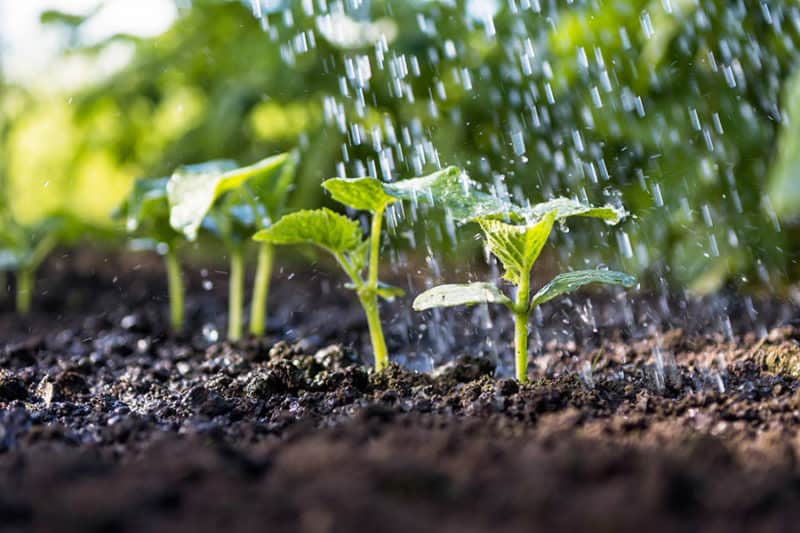
If temperatures are warm early enough, direct-sow seeds into the soil outside. You can create a hill (or small mound) of dirt to plant the seeds in, or you can dig a shallow hole in the garden to place the seeds in.
Either way, the seeds need to be placed one inch in the soil. Keep the soil moist until they sprout.
Plant Spacing
Cucumber seeds need to be planted 1 inch deep and 12 inches apart. Keep the row 2-3 feet apart if you’re using bush varieties.
Vine varieties should be 18 inches apart with 6 feet between rows.
Another option is to plant cucumbers in mounds or hills that are 1-2 feet apart with 2-3 seeds in each mound. Once the seeds sprout, thin to 1 sprout per hill.
Pick a Support System
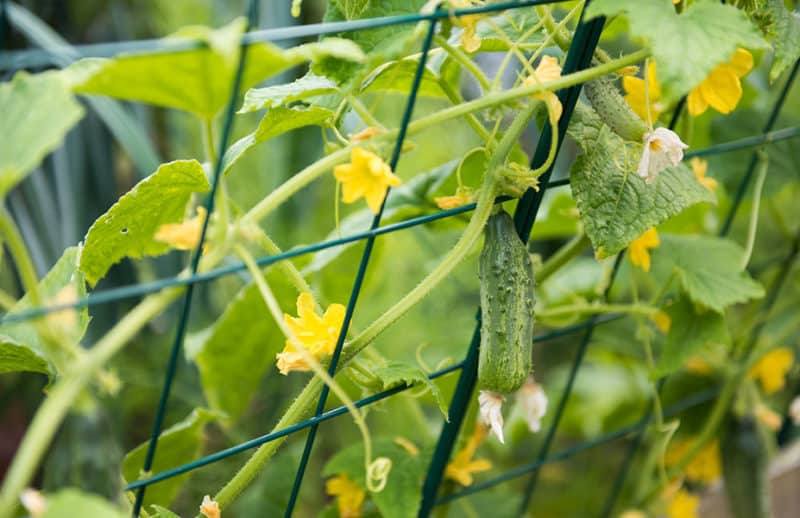
If you selected a vining cucumber, you need to have a trellis or arch to allow the vine to climb. Trellising protects the fruit from any damage if you left them to lay on the ground.
Another choice is to use stakes or tomato cages to hold up the cucumber plants. The vines have little tendrils that grab onto support structures.
Can You Grow Cucumbers in Containers?
Absolutely! In most cases, it’s best to select bush cucumbers, but you can add a trellis into your pot to grow vining cucumbers.
Growing cucumbers in containers requires a large pot with a lot of soil to help support their extensive root systems. Their roots grow vigorously, so pick a container that holds at least 5 gallons of soil for each plant.
When you grow cucumbers in pots, you need to check the soil moisture daily. Containers lose moisture faster than in-ground or raised bed gardening. So, check with your fingers each day to avoid the soil drying out and affecting the flavor of the cucumbers.
If you can stick your finger into the soil one inch and it’s dry, it’s time to water.
Fill the container with quality soil and compost. Plant two to three seeds per container. As long as you wait to plant when the weather is warm enough, you should have quality cucumbers in no time.
How to Care for Cucumbers in the Garden
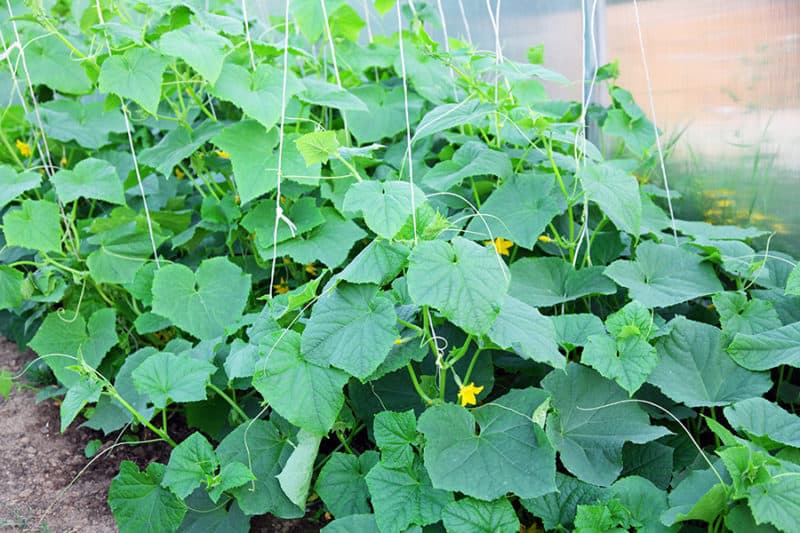
Now that the cucumbers are planted in your garden, you need to take care of them. Here are the key things to remember when growing cucumbers.
Watering Cucumbers
The most important part of growing cucumbers is remembering that they need to be watered – often. Consistent watering is key; they need 1-2 inches of water per week or more if the temperatures are high.
How do you know if your cucumbers need more water?
Put your finger into the soil need your plants. If it’s dry past the first joint of your finger, you need to water. You need to be consistent with your watering, or your plants will grow bitter-tasting.
The best time to water your plants is early in the morning or in the early afternoons. You want to avoid getting water on the leaves because that encourages diseases that could ruin your entire crop. It’s best to water your plants with a soaker hose or drip irrigation.
You need to increase watering as the fruits start to grow. When you see fruits forming, increase your watering to a gallon per week.
Fertilizing Cucumbers
If you added compost or other fertilizers to your soil before planting your cucumbers, you will only need to add some compost later in the growing season. Just put compost on the side of your plants.
Another choice is to use liquid fertilizer on your cucumber plants. Look for a fertilizer that is advertised as a vegetable plant food that has low nitrogen with high potassium and phosphorus.
Apply the liquid fertilizer when you plant the seedlings or seeds, a week after bloom and every 3 weeks after that. Another choice is to work a granular fertilizer into the soil, but be sure not to overfertilize or you’ll cause the fruit growth to slow.
Mulching Around Cucumber Plants
Mulch around cucumber plants after you plant them to stop weeds and pests from bothering the tender seedlings. Use straw, chopped leaves, grass clippings, or other organic mulches.
Problems with Cucumbers
Cucumbers have a few diseases and pests which could cause problems for your harvest. Here’s what you need to keep an eye out for:
Aphids
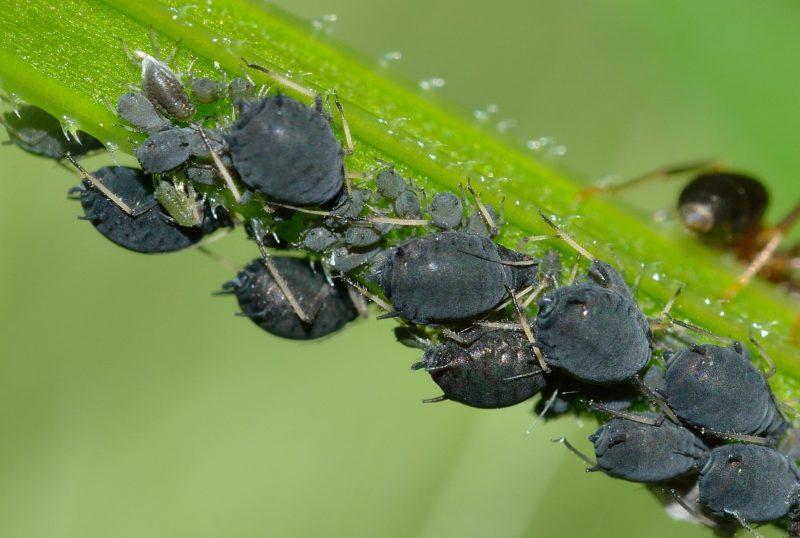
Aphids are tiny bugs that can be found attaching themselves to your plants. If you see them on your cucumbers, try giving them a spritz of cold water with your water hose.
However, if they remain attached, try hosing them down with soapy water. This should cause them to detach themselves from your plants.
Cucumber Beetles
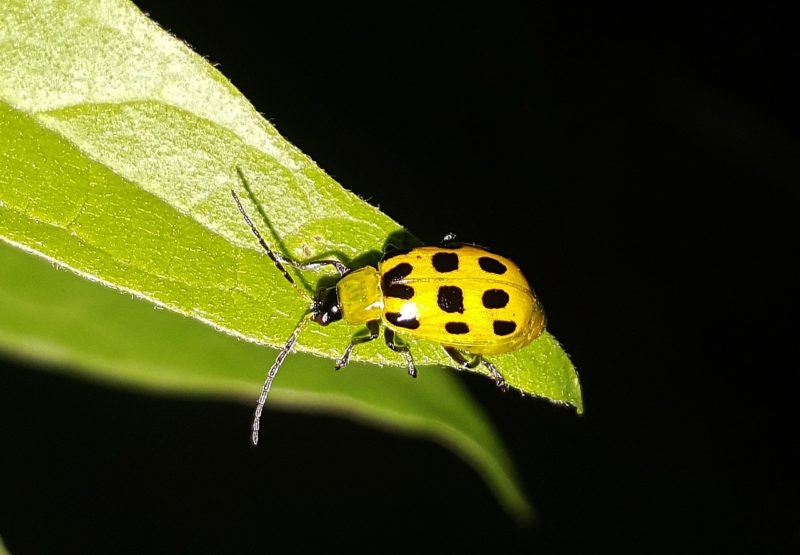
Cucumber beetles will cause a great deal of damage to your seedlings. They’re also known for spreading bacterial wilt.
The best option to deter them is to place row covers over your plants. Be sure to remove the row covers when your cucumbers bloom to leave room for pollinators.
Powdery Mildew
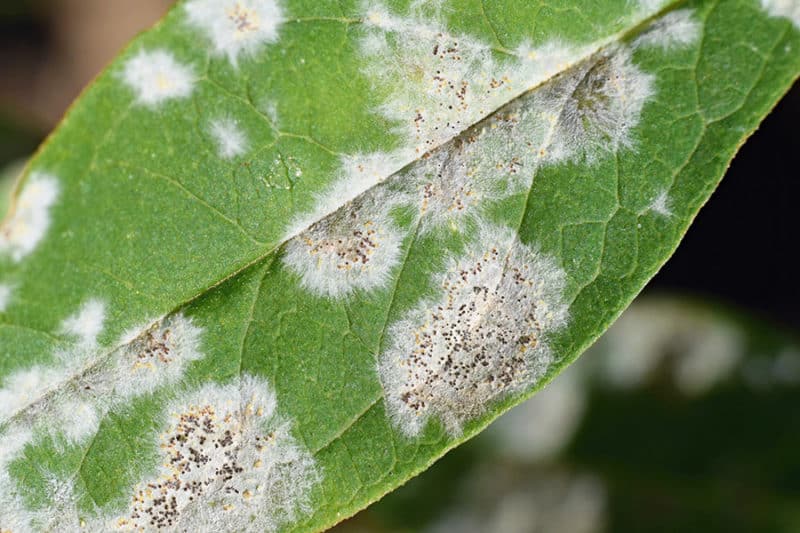
Powdery mildew is a mildew film which covers your plants. It occurs when the foliage of your plants become too wet.
The best way to deter powdery mildew is to water your cucumbers in enough time for the leaves to dry. You can also use a fungicide to rid your plants of this disease or rub the leaves together to brush the mildew off.
Spider Mites
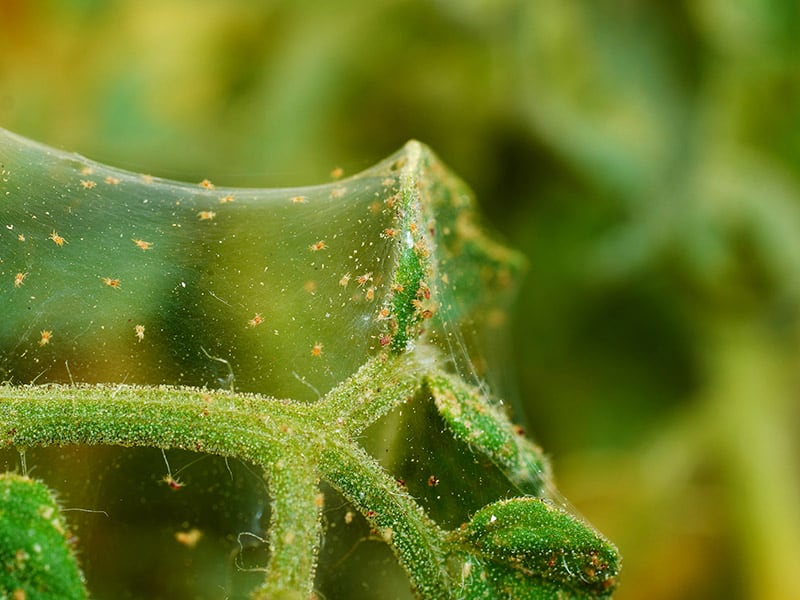
Spider mites will live on the leaves of your cucumber plants and drink the fluids from within the plant. You can rid your plants of these bugs with pesticides, keeping a clean garden, and by introducing beneficial insects.
Scab
Scab is a disease which most varieties of cucumbers are immune to today. If you run across it, you’ll notice your plants and fruits have dark scabs on them which lead to rot.
The best way to stay away from this disease is to practice crop rotation and leave ample space between cucumber plants to keep the leaves dry.
Fruiting Issues
While not a disease or a pest, cucumbers can have problems with developing little to no fruits. Not setting fruit isn’t a disease; it’s a pollination issue.
Just like zucchinis, cucumbers have male and female flowers that bloom and pollinators need to take pollen from the male flowers to the females. If you aren’t getting many fruits, it could be a lack of bees and other pollinators, excess rain, cold temperatures, or the use of insecticides.
You can pollinate by hand. Dip a cotton swab into pollen from the male flower and transfer it to the center of the female flower.
Best and Worst Companion Plants
There are certain plants cucumbers grow particularly well around. Those plants are:
There are plants that should be avoided around cucumbers as well. Those plants are:
How to Harvest and Store Cucumbers
Cucumbers are simple to harvest. You should pick them when they’re young. If you wait until they’ve been sitting on the vine for a few days at maturity, they become larger.
With the increase in size, their flavor becomes bitter, the seeds become larger, and they begin to turn yellow.
It’s a good idea to check your cucumber vines daily because it’s easy to overlook them when picking since the fruit and plant are the same color.
The smaller varieties should be picked when they’re approximately 6 inches long, and larger varieties should be picked when they’re around 8 inches long.
When it’s time to pick your cucumbers, use pruning shears or a sharp knife to cut them from the vine. This should help deter any damage to the plant.
Finally, you should wrap your cucumber harvest tightly in plastic wrap. This will help to maintain the moisture within the cucumber. They should last a week in your refrigerator.
If you have an abundance of cucumbers, consider making pickles and canning them.

